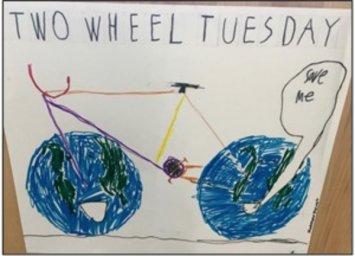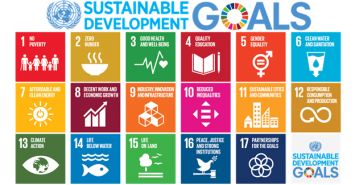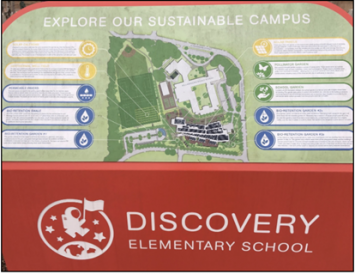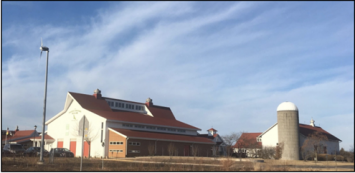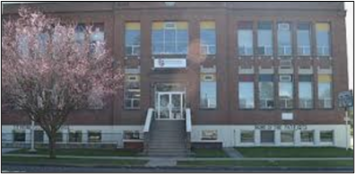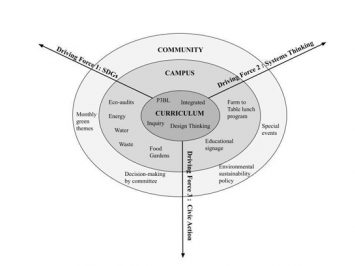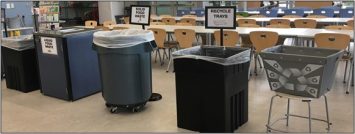Link to the General Issue December 2020 Table of Contents [2]
Hurd JSE December 2020 General Issue PDF [3]
Introduction
Sustainability education in K-12 schools can address the complex challenges facing our world by providing students with experience and knowledge about systems thinking, civic action, and the Sustainable Development Goals. We are calling for a transformation in the educational system in order to support collective and individual understanding and valuing of the environment as worth more preserved than destroyed. However, change is improbable as long as educational institutions maintain a pedagogy in which the teacher deposits information into the student, and the student relies on the teacher for knowledge; a whole school sustainability approach is preferable (Sterling, 2001; Wright, Cain & Monsour, 2015).
Whole-school sustainability (WSS) programs promote student-driven action across campus, curriculum, and community (Figure 1). In this type of constructivist educational system, teachers respond to student action, and this action determines which direction learning takes (Brooks & Brooks, 1993).
WSS programs equip students to create social change through an emphasis on teaching the following: 1) Sustainable Development Goals (SDGs); 2) systems thinking; and 3) civic action. This Introduction section presents a literature review and explanation of these three topics.
According to UNESCO (2005), with an eye on the well-being of future generations, learning should equip students to acquire:
“various critical and creative thinking skills, communication, conflict management and problem-solving strategies to take an active part in and contribute to the life of society; be respectful of the Earth and life in all its diversity; and be committed to promoting democracy in a society without exclusion and where peace prevails.”
Defining characteristics of WSS programs include: use of renewable energy for campus and building operations; reduced energy, waste and water usage; gardening programs linked to academic subjects; transdisciplinary and project-based learning; a community-wide vision of sustainability; and environmental community partnerships with local ecology and farm-to-table programs (Barr, Cross & Dunbar, 2014; Barr, Leigh & Dunbar, 2011; Birney & Reed, 2009; Elser, Pollari, Frisk & Wood, 2011; Henderson & Tilbury, 2004; Kajikawa, 2008; Scott, 2013; Warner & Elser, 2015).
There are several tools and educational resources that help schools implement sustainability education, including the Sustainable Development Goals (SDGs), civic action, and systems thinking. The aim of these resources is to create a solutions-minded society in which people have the skills and knowledge to enact change across society, the economy, and the environment. To address real-world issues in schools, problem-solving and critical thinking skills are indispensable tools for students (McKeown et al., 2002; Segalas et al., 2010; Wiek et al., 2011).
For example, for a school seeking to integrate the SDGs into the curriculum, Compass Education offers online lessons and tools (Compass Education, 2020). For a school wanting to incorporate civic action, A People’s Curriculum for the Earth is a book of curricular resources (Bigelow & Swinehart, 2014). Facing the Future creates teaching materials that help students develop a global perspective (FTF, 2020). Resources offered by Global Oneness Project document global stories of resilience and commitment to the planet (GOP, 2020). National Wildlife Federation’s Pathways to Sustainability presents environmental focus areas for student eco-action teams (NWF, 2020). For schools looking to implement a system-wide approach to sustainability education, Project Learning Tree offers training, curriculum, and a green schools program designed to engage children in learning through the environment (PLT, 2020). U.S. Department of Education Green Ribbon Schools highlights school sustainability practices and resources (US DOE, 2020). Eco-Schools also takes a system-wide approach to sustainability education with their global sustainable schools program (Eco-Schools, 2020). Green Schools National Network’s programs support the implementation of WSS programs in the United States (GSNN, 2018). The Cloud Institute for Sustainability Education connects school systems and their communities with meaningful educational content (Cloud Institute, 2020). Finally, the Center for Green Schools brings sustainability to life with their WSS programming (USGBC, 2020).
Sustainable Development Goals
Education for sustainable development (ESD) is a tool for achieving the SDGs. UNESCO (2010) outlined ESD as supporting global citizenship as a critical tool for changing organizations, governments, and communities. Behavior change such as natural resource management and responsible consumption and production result from including global citizenship principles in education (Chung & Park, 2016).
The SDGs were launched by United Nations member nations in 2015 with a target of completion by 2030 (UN, 2020a). They provide a framework for students to address global issues in K-12 schools (Figure 2). The SDGs can be used as a tool for helping students develop critical thinking skills necessary to address issues on local to global scales.
Civic action
In recent years, there has been an emphasis on K-12 students in different countries participating in civic action, through which students take part in decision-making processes (Wood, Taylor, Atkins & Johnston, 2018). Global citizenship is seen as a means to achieve sustainable development (Chung & Park, 2016); the level of citizen engagement increases as the educational focus shifts from knowledge to action (Crocco, 2020; Kahne & Sports, 2009).
One trend in global citizenship education is the emphasis on personal obligation to people and the planet (Crocco, 2020). Civic action such as writing to a state legislator or working on a service project can help young people cope with the difficult emotions raised by climate threats by showing them how to effectively take action instead of settling into feelings of denial or despair (Chawla, 2020).
Systems thinking
Systems thinking refers to the ability to analyze systems across different fields and disciplines (Meadows, 1997). Leverage points are places in a complex system in which one minor change can make a major shift. Often leverage points are counterintuitive, and people act in an opposite way than will actually create the desired change.
Approaching education from a perspective of systems thinking fosters an environment in which sustainability can be integrated across campus, curriculum, and community. Including systems thinking in K-12 education enables young people to consider sustainable development issues from multiple perspectives and work toward finding solutions to complex environmental, social, and economic problems (Frisk & Larson, 2011; Nolet, 2009; Wheeler et al., 2008; Wiek et al., 2011).
Taking a systems approach to curriculum design supports the acquisition of knowledge and skills for sustainable development. Since sustainability naturally involves systems, sustainability education curricula can link to systems thinking (Bernier, 2018).
Toward environmental justice
It is not enough to ask how we can build healthier, greener schools without first talking about and recognizing racial and social inequalities. Structures and institutions, including schools, perpetuate health problems based on race, class, and gender. Akom (2011, p. 832) defines eco-apartheid as “the interinstitutional arrangements and interactions that produce unequal environmental benefits and burdens based on race, class, gender, language, and immigration status, as well as their interconnections—and health and educational outcomes.” To achieve educational equity, neighborhood schools must contribute to environmental health.
We hypothesize that as K-12 schools place more emphasis on empowering students to face challenges and make relevant decisions for a sustainable world, students are more likely to develop the critical consciousness necessary to “take action against the oppressive elements of reality” (Freire, 1970, p. 60).
Methods
Our main research question was: how can WSS programs prepare students for solving today’s global issues? Also, how do WSS programs contribute to developing sustainable and ethically responsible behavior? And finally, what are teachers’ perceptions of the benefits of WSS?
Our theoretical and philosophical research framework was informed by educational principles of constructivism and inquiry-based learning. Within this educational framework, we believe that it is key for students to develop problem-solving and critical thinking skills.
We conducted semi-structured, face-to-face interviews in 2018 with 35 K-8 teachers and administrators at four schools in the United States. We used a mixed methods approach (Creswell, 2014; Neuman, 2015) to capture both qualitative and quantitative data, through interviews, class observations, and campus tours. Participants for the teacher and administrator interviews were selected by school liaisons, and we used snowball sampling to supplement this sample. The interviews, designed to last 20 minutes, were scheduled by school administrators and occurred on campus throughout the school day during teachers’ non-contact time. The interview questionnaire was developed based on a review of similar studies (e.g. Higgs and McMillian, 2006) as well as over 30 years of combined teaching experience of the authors. Teachers and administrators responded orally to demographic as well as open-ended and categorical questions. We wrote interviewee responses on paper, and then transcribed notes into a spreadsheet after each school visit.
Selection of classes for the educator observations was based on recommendations from school representatives and interview participants. Some teacher-participants invited us in advance to observe an active class. We also requested classroom visits with teachers based on their participation in sustainability education. The class observations were the duration of one class period, approximately 45 minutes long.
We took at least one formal school tour of each campus. The tours allowed us to observe and triangulate data about how each school integrates sustainability on campus.
The four sample schools were selected to represent a range of location, size, and type of school, including public, charter, or private school (Table 1). The schools were selected after initial research, including a literature review of WSS programs at schools in the United States. Some programs (Discovery Elementary and Prairie Crossing) were well-documented, but we also wanted to observe schools at other stages in WSS development and ability for program development and choice flexibility. For example, Spokane International Academy is a newer school and program.
Table 1. Characteristics of case study schools, 2018
| School | Location | Grade Levels | Public, Private, or Charter | Number of Students | Area Median Income |
| Discovery Elementary | Arlington, Virginia | PreK-5 | Public | 540 | $94,876 |
| Prairie Crossing Charter School | Grayslake, Illinois | K-8 | Charter | 432 | $82,881 |
| Whole Life Learning Center | Austin, Texas | PreK-8 | Private | 125 | $77,800 |
| Spokane International Academy | Spokane, Washington | K-8 | Charter | 189 | $52,955 |
Study Site Descriptions
Discovery Elementary is a public elementary school in a Virginia suburb, near the capital of the United States. Its net-zero energy campus frames learning with design thinking projects (Figure 3).
Prairie Crossing Charter School, a school in the midwestern US (Figure 4), contains gardens throughout campus. Teachers integrate gardening into the curriculum.
Whole Life Learning Center, a small, private school in the southern United States, offers a holistic learning program with a food forest at the heart of the campus and the program (Figure 5).
Spokane International Academy (SIA) is a public charter school in the northwestern United States (Figure 6). SIA offers the International Baccalaureate program, which prepares learners to be global citizens.
Questionnaire response data was analyzed by thematic coding of qualitative responses to open-ended questions and a quantitative analysis of closed categorical responses. Interview transcriptions and field journal notes revealed coding categories through conventional content analysis of repetitive words; we did not use predefined categories (Hsieh & Shannon, 2005). Categories that arose from the thematic analysis grouped similar statements together within a common theme.
We interviewed 26 teachers and nine administrators at four schools. Of those interviewed, the age range of 30 to 39 years old was more common than any other age range (Table 2).
Table 2. Overview of interview participants
| Gender | Female | Male | Prefer not to list | |
| 24 | 10 | 1 | ||
| Age | 20-29 years | 30-39 years | 40-49 years | 50-59 years |
| 4 | 13 | 11 | 7 | |
| Level of education | Bachelors | Other | Masters | Doctorate |
| 9 | 2 | 23 | 1 | |
| Years in education | < 5 years | 5-10 years | 10-15 years | > 15 years |
| 5 | 7 | 8 | 7 | |
In terms of level of education, more participants held a master’s degree than any other degree. More than half of the teachers interviewed had been teaching for ten or more years. For administrators interviewed, more than half had previously taught for ten or more years before becoming an administrator.
Results
The results are organized into subsections that contain specific SDG targets and school themes of curriculum, campus, and community that emerged from our research. Results from the case studies show a conceptual framework of how WSS can help meet the SDGs (Figure 7). There are several tools and educational resources that address the WSS driving forces — systems thinking, civic action, and SDGs.
In this section, we link SDGs and specific targets within the goals to the three WSS themes of curriculum, campus, and community.
Curriculum: Quality education (SDG 4)
Target 4.7
By 2030, ensure that all learners acquire the knowledge and skills needed to promote sustainable development, including, among others, through education for sustainable development and sustainable lifestyles, human rights, gender equality, promotion of a culture of peace and non-violence, global citizenship and appreciation of cultural diversity and of culture’s contribution to sustainable development (UN, 2020a, emphasis added).
Civic action, systems thinking, and SDGs in the curriculum
Our research indicated that WSS programs address local-global issues by engaging students in civic or service action. This helps them build the knowledge and skills needed to understand and promote sustainable development. Sustainable development necessitates having a different vision of the world and the capability to imagine a better quality of life, for everyone, even for future generations (UNESCO, 2005). A different vision of the world comes from a transformative education experience, which includes systems thinking, civic action, and learning about the SDGs.
Civic action takes the form of education experience through support projects and funding initiatives. For example, at Whole Life Learning Center, students experienced the process of seeking funding from a city waste management grant. At Prairie Crossing Charter School, students constructed water filters as a service action to support a local aid organization. When students study water as a system, they can make direct connections to civic action. Also at Prairie Crossing, students participated in international World Water Day (Figure 8) to celebrate the monthly sustainability theme of water.
Systems thinking is integrated into the campus, curriculum and community. As one teacher at Prairie Crossing Charter School said, “It’s so ingrained. It’s a part of everything.”
Sustainability is a system itself. At Discovery Elementary, systems thinking was observed in design thinking challenges. After the grounds staff mistakenly mowed the pollinator garden one summer, students designed colorful flower sculptures to attract pollinators to the garden for children to observe until pollinator plants filled in the area.
Campus: Sustainable communities and cities (SDG 11)
Target 11.6
By 2030, reduce the adverse per capita environmental impact of cities, including by paying special attention to air quality and municipal and other waste management (UN, 2020a, emphasis added).
Waste reduction and eco-audits
At least one administrator at each school mentioned waste reduction as a way that the school program promotes environmentally responsible behavior. Lunch waste was mentioned by administrators at three of the four schools. Waste reduction in the cafeteria involves recycling plastics, weighing food waste, and donating unopened containers of food (Figure 9).
In an Eco-studies class at Whole Life Learning Center, middle school students were finalizing a grant proposal for an updated campus waste management system. As a school administrator explained, “The students wrote the grant. If we receive the money, we will create signage and do workshops for staff and parents to learn more about compost and recycling.” This was part of a program offered through EcoRise in which students apply for funding for service projects. EcoRise is a non-profit organization that “empowers youth to tackle real-world challenges by teaching sustainability, design, and innovation” (EcoRise, 2020).
At Spokane International Academy, the environmental club manages cafeteria waste reduction. During a waste audit event, students initially dumped cafeteria garbage onto a tarp, put gloves on, and sorted through it. They organized the waste into recyclables, compost, and trash. Then, they weighed the waste. A competition between two lunch periods helped students evaluate who produced less waste.
Transportation
At Discovery Elementary, the monthly theme of transportation offered multiple opportunities for community members to take a step toward sustainable living and reducing air pollution. Eco-action student patrollers count the number of riders in each car and share the data with the community. In addition, Two-Wheel Tuesdays encourages a reduction of carbon emissions by promoting biking to school. The Green Team patrols the carpool line to track the number of cars, bikes, and buses. Transdisciplinary transportation projects tie in with art; students made sculptures and signage around campus (Figure 10).
Community: Sustainable communities and cities (SDG 11)
Target 11.7
By 2030, provide universal access to safe, inclusive and accessible, green and public spaces, in particular for women and children, older persons and persons with disabilities (UN, 2020a, emphasis added).
Spaces and places for community
Having spaces on campus that model sustainability builds a community-wide understanding of sustainability. “Simply live it (sustainability). Build it. Have it be the container. Experience it as part of the place.” This was the advice given by Whole Life Learning Center co-founder Caroline Carberry about how sustainability can be integrated into education through an emphasis on place using the school campus.
For example, students at Discovery Elementary used design thinking to develop prototypes for a campus outdoor sitting area. Collaborative spaces are built into the campus design at Discovery Elementary. There are multiple places for the community to come together. Special events on campus center on themes such as transportation and food sustainability.
The food forest at Whole Life Learning Center in Austin, Texas, is at the heart of the campus and the educational program (Figure 11).
Teachers use the food forest as a source for integrated curriculum, and children’s play in the food forest builds a love for nature. Garden beds are filled with vegetables, herbs, and medicinal plants. Berms and swales nurture the fruit trees and provide privacy on this two-acre campus. Berms and swales are a permaculture design technique used to control stormwater runoff and take advantage of rainwater. Permaculture is an approach to agriculture, design, and living that mimics systems and patterns found in natural ecosystems (Holmgren, 2002). The campus barnyard provides opportunities for students to care for chickens, goats, and ducks (Figure 12).
Discussion
Our research found that teaching with the SDGs, systems thinking, and civic action creates opportunities for students to address global issues and learn through applied WSS. The four schools we visited are all doing this to varying degrees. Other schools and organizations that are achieving this are described below, with examples for each theme.
Thinking in systems
Systems thinking can help young people participate in decision-making by deepening their understanding of cause and effect relationships regarding sustainable development (Meadows, 1997). Systems thinking is central to the work that Compass Education contributes to the field of sustainability education. Compass Education works with schools to make the 17 SDGs part of their standard operating procedure (United Nations, 2020b).
Compass is one of 20 organizations from the Americas, Asia, Africa, Europe, and Australia that make up the organization named 17Goals (United Nations, 2020c). 17Goals is part of the UN’s Partnerships for the Goals program. The objective of 17Goals is to raise awareness about the 17 SDGs by developing free, online, educational tools.
Systems thinking is not just a skill taught in class. Curriculum design reflects systems thinking, as well. Instead of a linear type of instruction with separate academic topics delivered by the teacher, a systems thinking approach offers learning experiences integrated across academic subjects. Sustainability integrates into all community events instead of appearing as a stand-alone event. Considering campus management from a systems thinking perspective enables school staff to analyze long-term and short-term trade-offs related to waste, water, and energy management.
Organizations that support schools operating as systems include the National Wildlife Federation’s Pathways to Sustainability (NWF, 2020). This is a program that provides a framework for WSS. In addition, The Cloud Institute for Sustainability based in Washington, DC has published sustainability indicators to focus the written curriculum on sustainability.
Civic action
Civic education can work to combat social inequities and environmental injustice. K-12 schools around the world have the potential to promote civic and political participation (Kahne & Sporte, 2009). For example, at a public charter school in Washington, DC, Mundo Verde students advocate for clean water through project-based learning initiatives. Mundo Verde “aims to foster high levels of academic achievement among a diverse group of students by preparing them to be successful and compassionate global stewards of their communities” (Mundo Verde, 2020). Civic action can give young people a sense of hope.
Quality and equitable education
Who has access to a healthy environment and quality education? In order to achieve SDG 4 (quality education for all), underserved communities need access to WSS programs as a means to academic achievement and environmental health. Education is a key for socioeconomic mobility (United Nations, 2020c). Access to resources and opportunities sits at the crux of the relationship between race, poverty, environmental health, and academic achievement. Structural racism limits people, especially people of color, from accessing resources and opportunities that promote health and academic achievement (Akom, 2011).
One way that sustainability education can be more equitable is through partnerships with non-profit organizations. Organizations such as EcoRise in Austin, Texas offer school-based WSS programs that narrow the gap of accessibility to quality sustainability programming for public schools with low budgets.
Educational equity takes center stage at The Academy for Global Citizenship (AGC), a public charter school in the midwestern US. Working with underserved communities in the Chicago area, AGC provides an academically rigorous, WSS program embedded in the International Baccalaureate (IB) program (Academy for Global Citizenship, 2020). IB is an inquiry-based program that emphasizes global citizenship and service learning. Students explore civic action and environmental justice issues across academic disciplines.
Another way that AGC works toward equity is by providing a healthy breakfast and lunch to community members. Due to COVID-19, temporary school closures had an impact on nutrition, as many families rely on schools for access to free breakfast and lunch. AGC delivered food to community members that normally received food from school (S. E. Ippel, personal communication, July 9, 2020).
Conclusion
Our research offers a snapshot of four schools in the United States practicing WSS (for more details, see Hurd and Ormsby, 2020). We hope that our findings can inform other schools pursuing or practicing WSS to implement additional programs.
The power of WSS programs lies in their potential to serve as models of sustainability education for other schools to replicate. Yet, questions remain. How does the green schools movement respond to growing issues of social, racial, and gender inequality? How can we implement WSS for all schools globally?
Most of the schools in this study had financial support and served wealthier communities; however, we have provided examples of partnerships and resources to achieve WSS initiatives at low cost. The WSS movement does need to be more inclusive. We can create green schools that focus on racial, economic, and social equity. In the future, we hope that similar research to our study can be undertaken at more schools, on a global scale.
References
Academy for Global Citizenship. (2020). About us. Retrieved July 27, 2020 from
https://agcchicago.org/school/our-mission/ [19]
Akom, A. (2011). Eco-apartheid: Linking environmental health to educational outcomes.
Teachers College Record, 113(4), 831-859.
Barr, S., Cross, J., and Dunbar, B. (2014). The whole-school sustainability framework. Fort Collins, CO: Institute for the Built Environment.
Barr, S., Leigh, K., and Dunbar, B. (2011). Green schools that teach. Fort Collins, CO: Institute for the Built Environment.
Bernier, A. (2018). How matching systems thinking with critical pedagogy may help resist the
industrialization of sustainability education. Journal of Sustainability Education, 18.
Bigelow, B. and Swinehart, T. (2016). A people’s curriculum for the Earth: Teaching climate
change and the environmental crisis. Milwaukee, WI: Rethinking Schools Publication.
Birney, A., and Reed, J. (2009). Sustainability and renewal: Findings from the leading
sustainable schools research project. Nottingham: National College for Leadership
of Schools and Children’s Services.
Brooks, J. and Brooks, M. (1993). In search of understanding: The case for constructivist
classrooms. Alexandria, VA: ASCD.
Chawla, L. (2020). Helping students cope with environmental change and take constructive civic
action. Green Schools Catalyst Quarterly, 7(1), 44-57.
Chung, B., and Park, I. (2016). A review of the differences between ESD and GCED in SDGs:
Focusing on the concepts of global citizenship education. Journal of International Cooperation in Education, 18(2), 17-35.
Cloud Institute for Sustainability Education. (2020). Retrieved August 11, 2020 from
https://cloudinstitute.org/mission-history [20]
Compass Education. (2020). Retrieved July 27, 2020 from http://www.compasseducation.org/ [21]
Creswell, J.W. (2014). A Concise Introduction to Mixed Methods Research. Thousand Oaks, CA: Sage Publications
Crocco, M. (2020). What does it mean to be a citizen in the 21st century? Fostering civic
engagement among youth in K-12 schools. Green Schools Catalyst Quarterly. 7(1),
15-27. Retrieved July 21, 2020 from
http://catalyst.greenschoolsnationalnetwork.org/gscatalyst/february_2020/MobilePagedA [22]
rticle.action?articleId=1559549&app=false#articleId1559549 [22]
EcoRise. (2020). About. Retrieved July 18, 2020 from https://ecorise.org/about/ [23]
Eco-Schools. (2020). Retrieved August 11, 2020 from
https://www.ecoschools.global/how-does-it-work [24]
Elser, M., Pollari, L., Frisk, E., and Wood, M. (2011). Linking curriculum and learning to
facilities: Arizona State University’s GK-12. Facility Planner, 45(3), 7.
Facing the Future (FTF). (2020). Facing the future. Western Washington University. Retrieved July 27, 2020 from https://cedar.wwu.edu/facingthefuture/ [25]
Freire, P. (1970). Pedagogy of the Oppressed. New York: Herter and Herter.
Frisk, E. and Larson, K. (2011). Educating for sustainability: Competencies and practices for
transformative action. Journal of Sustainability Education, 2(March), 1-20.
Global Oneness Project (GOP). (2020). Retrieved July 27, 2020 from
https://www.globalonenessproject.org/ [26]
Green Schools National Network. (2018). GSNN Catalyst Network. Retrieved from
https://greenschoolsnationalnetwork.org/network/ [27]
Henderson, K. and Tilbury, D. (2004). Whole-school approaches to sustainability: An
international review of sustainable school programs. Report prepared by the
Australian Research Institute in Education for Sustainability (ARIES) for The
Department of the Environment and Heritage, Australian Government.
Higgs, A. and McMillan, V. (2006). Teaching Through Modeling: Four Schools’ Experiences in Sustainability Education. The Journal of Environmental Education, 38(1), 39-53.
Holmgren, D. (2002). Permaculture: Principles and pathways beyond sustainability.
Victoria, Australia: Holmgren Design Services.
Hsieh, H. and Shannon, S. (2005). Three approaches to qualitative content analysis. Qualitative
Health Research, 15(9), 1277-1288.
Hurd, E. and A.A. Ormsby. (2020). Supporting K-12 teachers in the context of whole-school
sustainability: four case studies. Applied Environmental Education & Communication. DOI: 10.1080/1533015X.2020.1740115
Kahne, J. and Sporte, S. (2009). Developing citizens: The impact of civic learning opportunities
on students’ commitment to civic participation. In Civic Education and Youth Political
Participation (pp. 159-186). Leiden, Netherlands: Brill Sense.
Kajikawa, Y. (2008). Research core and framework of sustainability science. Sustainability Science, 3(2), 215-239.
McKeown, R., Hopkins, C., Rizi, R., and Christalbridge, M. (2002). Education for Sustainable
Development toolkit. Knoxville, TN: Energy, Environment and Resources Center, University of Tennessee.
Meadows, D. (1997). Leverage points: Places to intervene in a system. Whole Earth, 91(1),
78-84.
Mundo Verde. (2020). About. Retrieved July 28, 2020 from
http://www.mundoverdepcs.org/about [28]
National Wildlife Federation (NWF). (2020). Pathways to sustainability. Retrieved July 27, 2020 from https://www.nwf.org/Eco-Schools-USA/Pathways [29]
Neuman, L. (2015). Social Research Methods: Qualitative and Quantitative Approaches. London: Pearson Education Limited.
Nolet, V. (2009). Preparing sustainability-literate teachers. Teachers College Record, 111(2), 409-442.
Project Learning Tree (PLT). (2019). Retrieved July 27, 2020 from https://www.plt.org/ [30]
Scott, W. (2013). Developing the sustainable school: Thinking the issues through.
Curriculum Journal, 24(2), 181-205.
Segalas, J., Ferrer-Balas, D. and Mulder, K. (2010). What Do Engineering Students Learn in
Sustainability Courses? The Effect of the Pedagogical Approach. Journal of Cleaner
Production, 18(3), 275-284.
Sterling, S. (2001). Sustainable Education: Re-visioning Learning and Change. Bristol,
England: Schumacher Society.
UNESCO. (2005). UN Decade of Education for Sustainable Development, 2005-14: The DESD
at a glance. Retrieved July 29, 2019 from https://unesdoc.unesco.org/ark:/48223/pf0000141629 [31]
UNESCO. (2010). Education for Sustainable Development Lens: A policy and
practice review tool. Retrieved August 11, 2020 from
https://unesdoc.unesco.org/ark:/48223/pf0000190898 [32]
United Nations. (2020a). The Sustainable Development Agenda. Retrieved July 18, 2020 from
https://www.un.org/sustainabledevelopment/development-agenda/ [33]
United Nations. (2020b). Quality Education. Retrieved July 18, 2020
from https://www.un.org/sustainabledevelopment/education/ [34]
United Nations. (2020c). 17Goals. Retrieved July 28, 2020 from
https://sustainabledevelopment.un.org/partnership/?p=9651 [35]
U.S. Department of Education. (2020). Green Ribbon Schools. Retrieved August 5, 2020
from https://www2.ed.gov/programs/green-ribbon-schools/index.html [36]
U.S. Green Building Council. (2020). Retrieved August 11, 2020 from
https://www.centerforgreenschools.org/about [37]
Warner, B. and Elser, M. (2015). How do sustainable schools integrate sustainability
education? An assessment of certified sustainable K–12 schools in the United
States. Journal of Environmental Education, 46(1), 1-22.
Wheeler, G., Bergsman, K., Thumlert, C., and Kelly, B. (2008). Sustainable design project
teacher manual. Olympia, WA: Office of the Superintendent of Public Instruction.
Wiek, A., Withycombe, L., and Redman, C. (2011). Key competencies in sustainability: A
reference framework for academic program development. Sustainability Science,
6(2), 203-218.
Wood, B., Taylor, R., Atkins, R., and Johnston, M. (2018). Pedagogies for active citizenship:
Learning through affective and cognitive domains for deeper democratic engagement. Teaching and Teacher Education, 75, 259-267.
Wright, M., Cain, K., and Monsour, F. (2015). Beyond sustainability: A context for
transformative curriculum development. Transformative Dialogues: Teaching &
Learning Journal, 8(2), 1-19.
